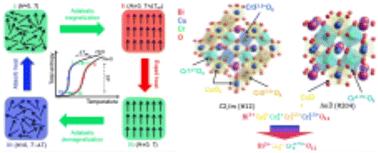利用电荷-自旋-晶格耦合研究BiCu3Cr4O12的巨磁热效应
IF 9.5
2区 材料科学
Q1 CHEMISTRY, PHYSICAL
引用次数: 0
摘要
全面研究了BiCu3Cr4O12的新型磁热效应,揭示了电荷-自旋-晶格耦合的复杂相互作用。利用第一性原理计算,本研究考察了电荷歧化和声子性质,揭示了结构和电子不稳定性背后的基本机制,以及材料的电子、晶格和磁相互作用中的强相关性。系统地推导了低温C2/m相和高温Im相两种不同晶相的磁交换耦合常数。结合经典海森堡模型和混合相模型,探讨了一阶磁相变与结构转变耦合的机理。用麦克斯韦关系成功地再现了混合相总磁化强度的巨大等温磁熵变化,证明了我们的模型和方法的准确性。此外,将克劳修斯-克拉珀龙方程应用于等温熵变,突出了晶格、电子和磁在磁热效应中的关键作用。这些发现说明了BiCu3Cr4O12中的强电荷、自旋和晶格相关性与只有磁性贡献的等温磁熵变化相比,如何显著增强等温熵变化。这项研究不仅加深了对磁热材料的认识,而且为开发节能制冷技术提供了宝贵的见解。本文章由计算机程序翻译,如有差异,请以英文原文为准。

Insights into the giant magnetocaloric effect in BiCu3Cr4O12 with charge–spin–lattice coupling
The novel magnetocaloric effect of BiCu3Cr4O12 is comprehensively investigated, revealing the intricate interplay of charge–spin–lattice coupling. Using first-principles calculations, this study examines charge disproportionation and phonon properties, uncovering the fundamental mechanisms behind structural and electronic instability, as well as strong correlations in the electronic, lattice, and magnetic interactions of the material. Magnetic exchange coupling constants are systematically derived for two distinct crystallographic phases: the low-temperature C2/m phase and the high-temperature Im![[3 with combining macron]](https://www.rsc.org/images/entities/char_0033_0304.gif) phase. By incorporating the classical Heisenberg model and a mixed-phase model, this work explores the mechanism of the first-order magnetic phase transition coupled with structural transformation. The giant isothermal magnetic entropy changes are successfully reproduced using Maxwell relations for the total magnetization of mixed phases, demonstrating the accuracy of our models and methods. Additionally, applying the Clausius–Clapeyron equation to the isothermal entropy change highlights the critical role of lattice, electronic, and magnetic contributions in the magnetocaloric effect. These findings illustrate how strong charge, spin, and lattice correlations in BiCu3Cr4O12 significantly enhance the isothermal entropy change compared to the isothermal magnetic entropy change with only the magnetic contribution. This study not only deepens the understanding of magnetocaloric materials but also offers valuable insights for developing energy-efficient refrigeration technologies.
phase. By incorporating the classical Heisenberg model and a mixed-phase model, this work explores the mechanism of the first-order magnetic phase transition coupled with structural transformation. The giant isothermal magnetic entropy changes are successfully reproduced using Maxwell relations for the total magnetization of mixed phases, demonstrating the accuracy of our models and methods. Additionally, applying the Clausius–Clapeyron equation to the isothermal entropy change highlights the critical role of lattice, electronic, and magnetic contributions in the magnetocaloric effect. These findings illustrate how strong charge, spin, and lattice correlations in BiCu3Cr4O12 significantly enhance the isothermal entropy change compared to the isothermal magnetic entropy change with only the magnetic contribution. This study not only deepens the understanding of magnetocaloric materials but also offers valuable insights for developing energy-efficient refrigeration technologies.
![[3 with combining macron]](https://www.rsc.org/images/entities/char_0033_0304.gif) phase. By incorporating the classical Heisenberg model and a mixed-phase model, this work explores the mechanism of the first-order magnetic phase transition coupled with structural transformation. The giant isothermal magnetic entropy changes are successfully reproduced using Maxwell relations for the total magnetization of mixed phases, demonstrating the accuracy of our models and methods. Additionally, applying the Clausius–Clapeyron equation to the isothermal entropy change highlights the critical role of lattice, electronic, and magnetic contributions in the magnetocaloric effect. These findings illustrate how strong charge, spin, and lattice correlations in BiCu3Cr4O12 significantly enhance the isothermal entropy change compared to the isothermal magnetic entropy change with only the magnetic contribution. This study not only deepens the understanding of magnetocaloric materials but also offers valuable insights for developing energy-efficient refrigeration technologies.
phase. By incorporating the classical Heisenberg model and a mixed-phase model, this work explores the mechanism of the first-order magnetic phase transition coupled with structural transformation. The giant isothermal magnetic entropy changes are successfully reproduced using Maxwell relations for the total magnetization of mixed phases, demonstrating the accuracy of our models and methods. Additionally, applying the Clausius–Clapeyron equation to the isothermal entropy change highlights the critical role of lattice, electronic, and magnetic contributions in the magnetocaloric effect. These findings illustrate how strong charge, spin, and lattice correlations in BiCu3Cr4O12 significantly enhance the isothermal entropy change compared to the isothermal magnetic entropy change with only the magnetic contribution. This study not only deepens the understanding of magnetocaloric materials but also offers valuable insights for developing energy-efficient refrigeration technologies.
求助全文
通过发布文献求助,成功后即可免费获取论文全文。
去求助
来源期刊

Journal of Materials Chemistry A
CHEMISTRY, PHYSICAL-ENERGY & FUELS
CiteScore
19.50
自引率
5.00%
发文量
1892
审稿时长
1.5 months
期刊介绍:
The Journal of Materials Chemistry A, B & C covers a wide range of high-quality studies in the field of materials chemistry, with each section focusing on specific applications of the materials studied. Journal of Materials Chemistry A emphasizes applications in energy and sustainability, including topics such as artificial photosynthesis, batteries, and fuel cells. Journal of Materials Chemistry B focuses on applications in biology and medicine, while Journal of Materials Chemistry C covers applications in optical, magnetic, and electronic devices. Example topic areas within the scope of Journal of Materials Chemistry A include catalysis, green/sustainable materials, sensors, and water treatment, among others.
 求助内容:
求助内容: 应助结果提醒方式:
应助结果提醒方式:


